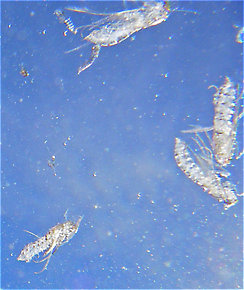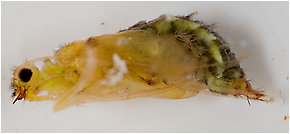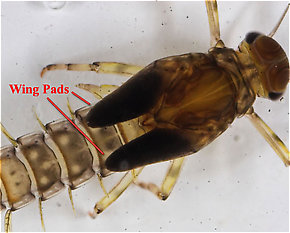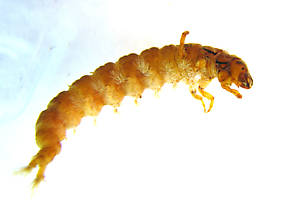Blog & Latest Updates
Fly Fishing Articles
Insects by Common Name


Caddisfly Genus Hydropsyche (Spotted Sedges)
Taxonomic Navigation -?-
Kingdom
Animalia (Animals)
» Phylum
Arthropoda (Arthropods)
» Class
Insecta (Insects)
» Order
Trichoptera (Caddisflies)
» Family
Hydropsychidae
» Genus Hydropsyche (Spotted Sedges)
50 species aren't included.
Common Name
| Match | Common Name |
| Spotted Sedges |
More to come - Page in edit mode.
Pictures of 11 Caddisfly Specimens in the Genus Hydropsyche:
Hydropsyche aenigma (Spotted Sedge) Caddisfly Adult View 18 PicturesThese big caddisflies were tempting trout as they wriggled out of their shucks (
View 18 PicturesThese big caddisflies were tempting trout as they wriggled out of their shucks ( Shuck: The shed exoskeleton left over when an insect molts into its next stage or instar. Most often it describes the last nymphal or pupal skin exited during emergence into a winged adult.), while others skated across the water at a medium pace, probably egg-laying.
Shuck: The shed exoskeleton left over when an insect molts into its next stage or instar. Most often it describes the last nymphal or pupal skin exited during emergence into a winged adult.), while others skated across the water at a medium pace, probably egg-laying.
 View 18 PicturesThese big caddisflies were tempting trout as they wriggled out of their shucks (
View 18 PicturesThese big caddisflies were tempting trout as they wriggled out of their shucks (
Here's an underwater view of the pupal shucks of several already-emerged Brachycentrus numerosus caddisflies.
Collected May 15, 2007 from the West Branch of the Delaware River in New York
Added to Troutnut.com by Troutnut on May 18, 2007
Added to Troutnut.com by Troutnut on May 18, 2007
Hydropsyche (Spotted Sedges) Caddisfly Pupa View 8 PicturesSeveral users have interesting comments in the discussion of this specimen, but this observation by Creno is especially good:
View 8 PicturesSeveral users have interesting comments in the discussion of this specimen, but this observation by Creno is especially good:
 View 8 PicturesSeveral users have interesting comments in the discussion of this specimen, but this observation by Creno is especially good:
View 8 PicturesSeveral users have interesting comments in the discussion of this specimen, but this observation by Creno is especially good:Also, this is what I would call an "immature" pupa. The wingpads of caddis pupae darken to nearly black as the enclosed adults near emerging. The darkening is the developing adult wing inside the pupal wing pad (Wing pad: A protrusion from the thorax of an insect nymph which holds the developing wings. Black wing pads usually indicate that the nymph is nearly ready to emerge into an adult.). The ultimate coloration of the adult wing is not very apparent in most pupal wing pads ( The wing pads on this final instar Baetidae mayfly nymph are extremely dark.Wing pad: A protrusion from the thorax of an insect nymph which holds the developing wings. Black wing pads usually indicate that the nymph is nearly ready to emerge into an adult.) as the majority of the adult wing coloration comes from the color/position of the adult wing hairs and setae (Seta: Little hairs on insects.). But dark pupal wingpads are a good indication that the emergence will occur very soon, likely that day or so, and that the adult parts are sufficiently developed within the pupae to make a species determination from the specimen, particularly if it is a male.
The wing pads on this final instar Baetidae mayfly nymph are extremely dark.Wing pad: A protrusion from the thorax of an insect nymph which holds the developing wings. Black wing pads usually indicate that the nymph is nearly ready to emerge into an adult.) as the majority of the adult wing coloration comes from the color/position of the adult wing hairs and setae (Seta: Little hairs on insects.). But dark pupal wingpads are a good indication that the emergence will occur very soon, likely that day or so, and that the adult parts are sufficiently developed within the pupae to make a species determination from the specimen, particularly if it is a male. The wing pads on this final instar Baetidae mayfly nymph are extremely dark.
The wing pads on this final instar Baetidae mayfly nymph are extremely dark.
Collected May 13, 2007 from the Delaware River in New York
Added to Troutnut.com by Troutnut on May 18, 2007
Added to Troutnut.com by Troutnut on May 18, 2007
Hydropsyche californica (Spotted Sedge) Caddisfly Larva View 5 PicturesSize - 14 mm
View 5 PicturesSize - 14 mm
Condition - preserved
Habitat - cobble bottom, moderate flow run, at a depth of approx. 1 1/2 feet.
Key Characters - pair of large prosternal sclerites (Sclerite: A hard plate of chitinous material, such as those that form the exoskeletons of arthropods, uninterrupted by cracks or sutures.)
This is a very common taxon at this location. I collected using a kick net. In life, it is bright olive green ventrally, shading to a dull olive at its dorsal (Dorsal: Top.) abdominal surfaces. In the hand, the legs, thoraxic regions, and head appear medium chocolate brown. The stark contrast of the thoraxic plate's dark edges and light legs are effects of preserving. The plumouse anal hooks were duck down gray, not the color of the gills as appears in the preserved specimen.
The Lower Yuba River is a good habitat for this species, being a larger river with an open canopy. The Feather River just to the north of the Yuba system also finds H. californica in abundance. The other common Hydropsyche species in the area, Hydropsyche occidentalis, seems to prefer smaller, shaded streams.
Entoman
 View 5 PicturesSize - 14 mm
View 5 PicturesSize - 14 mmCondition - preserved
Habitat - cobble bottom, moderate flow run, at a depth of approx. 1 1/2 feet.
Key Characters - pair of large prosternal sclerites (Sclerite: A hard plate of chitinous material, such as those that form the exoskeletons of arthropods, uninterrupted by cracks or sutures.)
This is a very common taxon at this location. I collected using a kick net. In life, it is bright olive green ventrally, shading to a dull olive at its dorsal (Dorsal: Top.) abdominal surfaces. In the hand, the legs, thoraxic regions, and head appear medium chocolate brown. The stark contrast of the thoraxic plate's dark edges and light legs are effects of preserving. The plumouse anal hooks were duck down gray, not the color of the gills as appears in the preserved specimen.
The Lower Yuba River is a good habitat for this species, being a larger river with an open canopy. The Feather River just to the north of the Yuba system also finds H. californica in abundance. The other common Hydropsyche species in the area, Hydropsyche occidentalis, seems to prefer smaller, shaded streams.
Entoman
Collected March 9, 2011 from the Lower Yuba River in California
Added to Troutnut.com by Entoman on November 2, 2011
Added to Troutnut.com by Entoman on November 2, 2011
Recent Discussions of Hydropsyche
Correct hatch time of year Hydropsyche slossonae? 10 Replies »
Posted by AndyV on Aug 26, 2022 in the species Hydropsyche slossonae
Last reply on Oct 11, 2022 by AndyV
I've seen hatch charts (e.g. DNR hatch chart for SE MN) stating mid-May til the end of July vs June (from this site). Can anyone confirm?
ReplyYour Thoughts On Hydropsyche:
Top 10 Fly Hatches
Top Gift Shop Designs
Eat mayflies.
Top Insect Specimens
Miscellaneous Sites
Troutnut.com is copyright © 2004-2024 Jason
Neuswanger (email Jason). See my FAQ for information about use of my images.
 privacy policy
privacy policy
